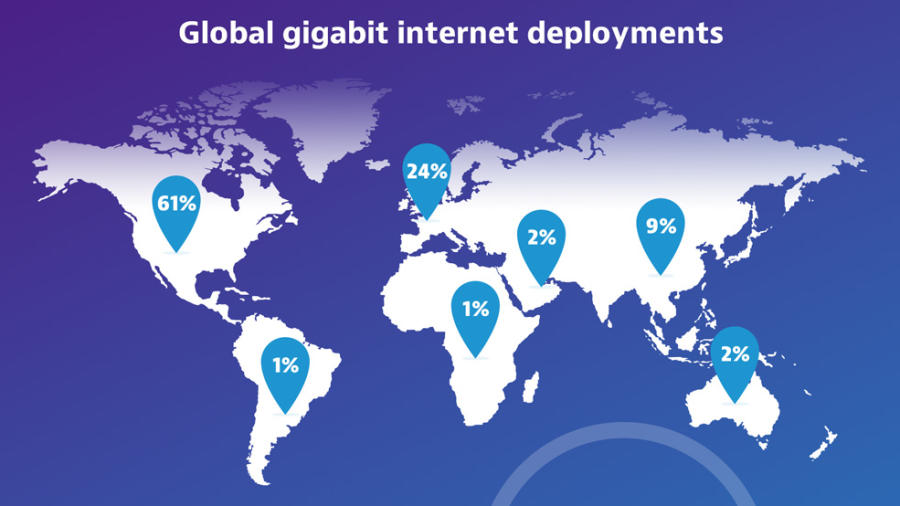This is why gigabit internet is such a big deal

You’re watching the Game of Thrones episode you’ve been looking forward to all week, and just when you get to the pivotal scene, the stream cuts out, forcing you to adopt the salty language the show itself is known for. Your slow internet connection and your modem might face your wrath! Deep breath. Keep calm. Changes are afoot and internet connections are getting faster. How much faster?
Gigabit internet is the next generation of broadband technology and it is 159 times faster than the global average of 6.3 Mbps. A cross section of wired and wireless operators are all racing to deploy gigabit connectivity to feed our insatiable appetite for bandwidth. After all, Game of Thrones is renowned for building whole new worlds that were hardly possible on a television show just a few years ago, and communication service providers realize they’ve got to keep up.
A kick up the internet
It is clichéd, but gigabit is actually transformational. Yes, you can download that Game of Thrones episode in HD within a matter of a few seconds. But, there’s more to it than that. Ultra-fast internet connections could empower enterprises and the public sector. Imagine being able to transfer large files within a swipe, have smooth HD conference calls and have instant access to data -- no matter the location. All with lightning-fast connectivity and no frozen screens or buffering. Think of the Internet on steroids, with enough speed to connect all the ‘things’ in the Internet of Things (IoT) without breaking a sweat.
For public services, it could mean faster response times when it comes to care for the elderly or vulnerable. Intelligent always-connected HD cameras could replace panic buttons if a person falls or is in danger. Overhead cameras could intelligently feed information to police offers to manage crowd-control. IoT connected devices and sensors could help emergency responders locate victims of an earthquake or fire much faster.
Gigabit is also a driver for growth and jobs. In a study conducted by the Analysis Group, they found that 14 communities in their research secured just over $1 billion in additional GDP when gigabit broadband became widely available. That’s why governments across the world from the US to Australia are keen to deploy the next generation of internet.
So, how widely available is gigabit internet?
The progress of gigabit deployments across the world can be seen via the Gigabit Monitor. It is a visual database referencing current and planned installations. There are more than 500 operational or planned deployments globally and the majority of installations took place in the past couple of years.
Taking a bird’s eye view of the global data on the Gigabit Monitor, the United States has the highest number of gigabit deployments in the world. As such, the bulk of global gigabit deployments are in North America and Europe. Asia is third and that’s followed by Australasia, Middle East, Africa and South America.
Blighty Gigabit!
The European gigabit landscape is interesting. The UK has the largest number of ultra-fast internet connections -- existing and planned. In a post-Brexit Europe, the UK may have a connectivity edge over its European counterparts. Other European nations with significant gigabit installations include Sweden, Germany and Switzerland.
Over in Asia, Singapore has taken a giant technological leap in making its country a 'smart nation' -- no wonder it has the highest number of gigabit connections in the region. The city state is followed by South Korea, China and Hong Kong.
In the Middle East and Africa, South Africa has the highest number of deployments followed by the United Arab Emirates. To power the region’s economies, new deployments have been planned in a number of countries including Saudi Arabia, Kuwait, Israel and Zimbabwe. In South America, gigabit is favored by Brazil, Peru and Bolivia.
Set gigabit free
When it comes to deployment, wireline and wireless operators are looking at different technologies including GPON, DOCSIS 3.1, G.fast, LTE-A and 802.11ac. The majority of known gigabit deployments are based on optical fiber connectivity. Several network provides used Hybrid-Fiber Coax (HFC), a broadband technology that combines optical fiber and coaxial cable, commonly employed by cable providers.
Some wireless deployments are based on Long Term Evolution-Advanced (LTE-A), a modified version of LTE, which deliver faster and larger mobile-data payloads. The next standard in mobile is 5G and over 30 wireless carriers have announced plans for 5G networks. What’s more 5G networks could be built as early as next year.
The numbers keep on coming!
There’s no doubt, the gigabit revolution is in full swing. And the need for more internet speed keeps on growing. Cisco has some eye-watering figures. It estimates that there are more than 20 billion connected devices across the world right now -- from consumer tech to industrial Internet of Things (IIoT). That figure could be close to 40 billion in two years. Internet traffic in 2020 will reach 5.3 Exabytes per day. In 2020 the gigabyte equivalent of all movies ever made will cross the internet every 2 minutes. Wow.
And it is not just us consumers who want more bandwidth, so do enterprises. Earlier this year The State of the Network study found that a quarter of businesses projected their bandwidth growth to be over 150 per cent and were deploying 100 Gigabit Ethernet (100 GbE)!
And finally, it is projected that gigabit-per-second connections will increase tenfold to over 10 million by the end of 2016. That probably is good news for Game of Thrones fans who want faster internet speeds -- and wait zealously for season 7.
Sameh Yamany, Chief Technology Officer, Viavi Solutions
Published under license from ITProPortal.com, a Net Communities Ltd Publication. All rights reserved.